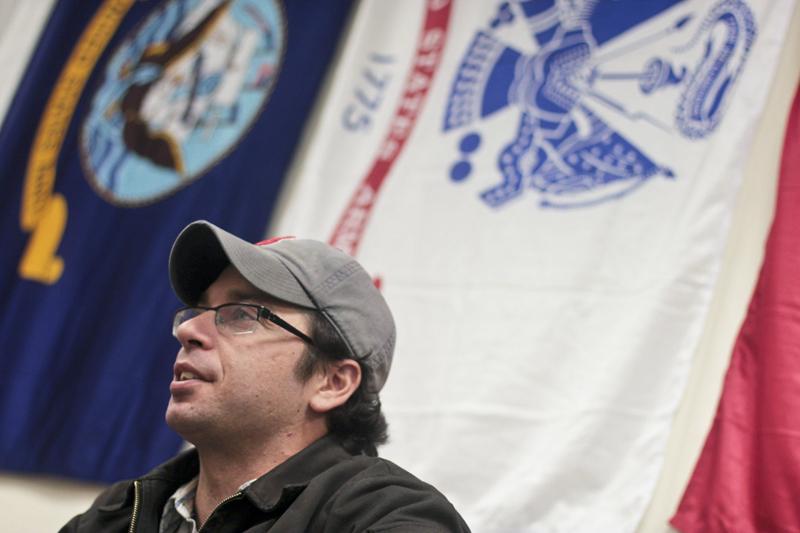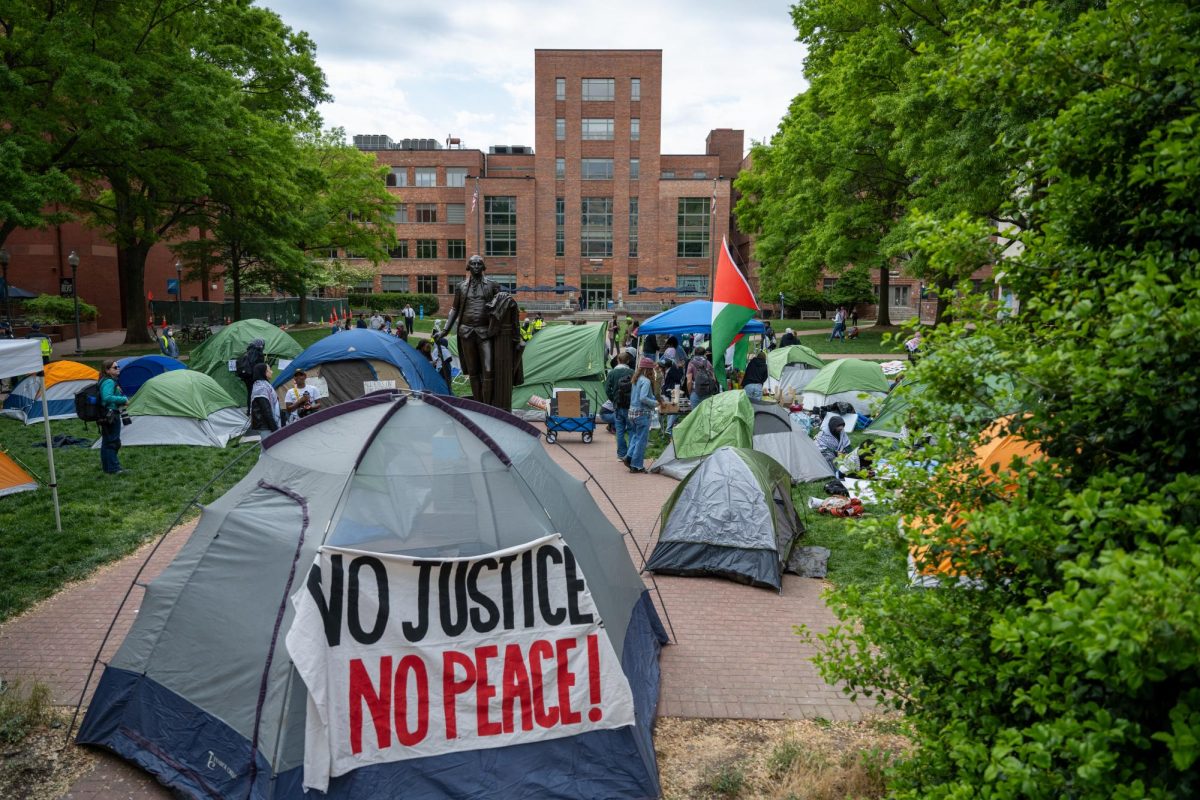At the Student Veterans of America conference last January, hundreds of former service members complained about running into red tape and dealing with unresponsive university administrators.
But a group of veterans from GW painted a different picture. Tommy Davis, president of GW Veterans, shared his success in lobbying and working with administrators over the last two and a half years.
The University created a top administrative position to focus just on veterans and service members, bringing in a retired nuclear submariner. New counseling and career programs now aim to help former military members transition to civilian life.
“Just keep speaking your voice to the administration and eventually something will happen. You just can’t stop fighting,” Davis remembers telling his peers at the conference. “But you know, veterans are used to winning uphill battles anyways.”
The advocacy for improved veterans services and expanded academic programs has helped win some of the best possible results – both for students and the University’s bottom line.
You don’t have your platoon anymore, you don’t have your fire team or your tank crew. You get off the Metro at Foggy Bottom and you’re like, ‘Alright, here I go,'”
– Dominic Amaral
By committing millions of dollars to help veterans afford a GW education, the University is enrolling more students who are primarily bankrolled by the federal government. In turn, the University is planning a host of academic programs geared toward military members and veterans to generate nearly $2 million in extra revenue.
The University’s focus on extra on-campus support to help veterans transition out of uniform and into civilian life has bolstered its reputation as a military-friendly university Dominic Amaral, a 26-year-old undergraduate who served as an army tank gunner before coming to GW.
“You don’t have your platoon anymore, you don’t have your fire team or your tank crew. You get off the Metro at Foggy Bottom and you’re like, ‘Alright, here I go,'” Amaral said.
He is one of more than 500 students enrolled at GW as part of the Post 9/11 GI Bill, which became law in 2008 and offers college aid to former service members. About two-thirds of those 538 veterans last year were enrolled in graduate programs.
In the more than two years Amaral has been at GW, he said the school has become a “GI magnet.” In fact, GW’s veterans population has grown by about 300 percent since the passage of the Post 9/11 GI Bill.
That’s partly because the support at GW is “unlike anything I had heard from any of my counterparts,” he said.
Locking in on support
Members of Congress and higher education experts have complained that some universities, especially for-profit colleges, delivering subpar services and academic experiences to veterans who arrive with coveted federal dollars.
GW has tried to plow a different path. Veterans can meet with a specific career center adviser, seek therapy from a U.S. Army veteran and participate in a unique orientation program their first day on campus. And this summer, the University joined the VetSuccess on Campus program that permanently deploys a vocational counselor from the Department of Veterans Affairs to Foggy Bottom.
“There are a lot of schools beginning to jump on that bandwagon of veteran friendliness, but they still haven’t quite gotten there,” said Derek Regier, a former marine and Elliott School of International Affairs senior. “GW is not just giving lip service to it, but following through in very concrete ways.”
University President Steven Knapp said GW’s commitment to veterans reflects GW’s values and identity going back to the University’s namesake. It’s also fitting because GW enrolled the first recipient of GI Bill benefits after World War II, he added.
“GW is not just giving lip service to it, but following through in very concrete ways.”
– Derek Regier
“Considering all those factors, how could we not respond to the veterans who are now returning to civilian life after a decade of war?” Knapp said in an email.
The University even included veteran enrollment as one of the goals listed in its decade-long strategic plan, aiming to boost its population of roughly 1,000 military-affiliated students, which includes students whose family members are in the armed forces. That commitment prompted the University to hire retired vice admiral Mel Williams as senior associate dean of military and veterans initiatives.
“As many of the military members, veterans and their families think about learning and advancing their careers, we stand to gain by embracing them on our campus to help provide them with a quality GW learning experience,” said Williams, a retired nuclear submariner.
Most of the support programs cropped up over the last year since the University hired Mike Ruybal to head the Office of Military and Veterans Support Services. In his time at the helm, Ruybal has hired more federal work-study students and a full-time staff member who processes veterans’ paperwork with the U.S. Department of Veterans Affairs.
Yellow Ribbon Program
What is it?
Since 2009, GW has participated in the Yellow Ribbon Program, which bridges the gap between tuition costs and education funding from the post-9/11 GI Bill, and today commits up to $18,000 per undergraduate student and up to $12,000 per student for most of its graduate programs each year. Under the program, the Department of Veterans Affairs matches the University’s contribution.
By comparison, Georgetown University will only dole out up to $5,000 per student for nearly all of its undergraduate programs and up to $2,500 for graduate programs in its school of arts and sciences.
How many students are involved?
In the last academic year, 538 students were able to afford a GW education through the Yellow Ribbon Program, a group which comprised 152 undergraduates, 357 graduate students, and 29 law students.
The university awarded more than $26,000 on average in need-based scholarships and grants alone to undergraduate students who demonstrated financial need. But after the Department of Veterans Affairs deposits more than $33,000 into GW’s bank account per student, the university is left with clearing just over $14,000 of veteran’s nearly $48,000 in undergraduate tuition and fees.
What does the future look like?
As part of GW’s efforts to find additional revenue streams, the university’s Innovation Task Force drew up plans last spring to bring in $1.8 million in added revenue by creating programs for military servicemembers and veterans.
There are approximately 1,050 military-affiliated students enrolled at GW.
Ruybal said his daily interactions with veterans prompted him to push for services like a specialized clinician in the University Counseling Center.
“The need came straight from the student veterans themselves. They wanted it,” Ruybal said. “It’s having somebody to go in, to be able to speak to, that can actually understand you.”
The University has come a long way since 2009, when it hired its first veterans coordinator to help the 300 students. That was the first year GW joined the Yellow Ribbon Program, where the government matches financial aid dollars for veterans put up by over 1,000 colleges.
A financial upside
As student veterans scope out their options, GW also hopes the University will stand out for its level of support and financial aid.
GW has already been named one of the nation’s most military-friendly schools for the last five years by G.I. Jobs magazine and commits up to $18,000 per undergraduate student and up to $12,000 for most graduate students – funds that are matched by the VA under the Yellow Ribbon Program.
By comparison, Georgetown and Tufts universities dole out up to $5,000 per undergraduate, while New York University pays up to $3,500.
And while GW’s financial commitment tops other peer schools, one expert said that veteran populations are also good for universities “on a dollars and cents angle.”
“Most of the time, if you’re a vet, Uncle Sam is paying for your tuition, or at least most of it, and when that’s happening at the school, you don’t have to worry about a late tuition payment, you don’t have to worry about chasing down students,” said George Altman, a reporter for the Military Times magazine. “Uncle Sam is going to give you the money.”
But after the VA pays nearly 70 percent of GW’s nearly $48,000 in undergraduate tuition and fees, the University is left with only about $14,000 of a veteran’s bill. That compares to an average of $26,000 in need-based aid given to the overall undergraduate population.

The University’s Innovation Task Force, which is charged with thinking up new strategies to save and create revenue, calculated that GW could bring in about $1.8 million in added revenue through military-affiliated programs. These are mostly classes that active-duty members can take online or at U.S. military bases in the area, like Fort Belvoir.
Charting GW’s future for veterans
Now, University officials are preparing for more military-affiliated students to enroll as the U.S. draws out of more than a decade of war and more soldiers, sailors and marines look to earn degrees.
Over the next year, GW will build up its off-campus programs in Hampton Roads, Va., where about 18 percent of students have ties to the military.
Greg Logan, who directs the center at Hampton Roads, said the campus will expand to up to 15 classrooms this year with more faculty from GW’s main Foggy Bottom campus – up from little more than a handful of faculty and five classrooms.
To help faculty and staff relate to and understand the veteran population, Ruybal and student veterans are organizing monthly, six-hour training sessions that immerse participants in military life, from boot camp to deployment, to returning home and jumping into academia.
But as GW continues to grow its military population, Davis, the GW Veterans leader, said the University needs to expand mental health services for veterans, as one in five veterans from the wars in Iraq and Afghanistan develops post-traumatic stress disorder.
He said he wants GW to be the first college to bring VA doctors and mental health professionals to campus on a regular basis, and has already begun talks with officials around the city to make it happen.
“As GW continues this push to make us the most military-friendly school in the country – you know, probably the world – I think that that would be one thing that would really distinguish them,” Davis said. “Too many guys fall through the cracks and it’s very serious.”
At the end of the day, Amaral said he and the other veterans are students, just like the 20,000 other people enrolled in classes at GW.
“To get here, we just took a different road, even though mine probably had a few more IEDs on it,” he said.








